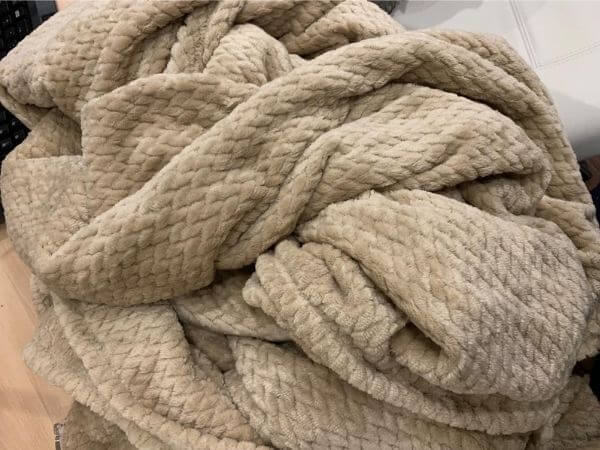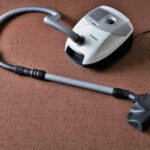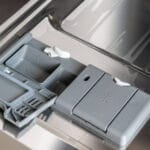When you finally get hold of OH SO SOFT and squishy fleece, the last thing you want is to damage the luxurious texture with a poor washing and maintenance routine.
And this is a problem so common that we have many people enquire why their snuggly blanket looks matted and out of shape after the first wash.
I don’t need to lie—sometimes you will buy a poor-quality fleece that will compress or shrink unevenly no matter how you wash it. But the opposite is true. Premium quality fleece items stay in shape when you follow the right washing and drying procedure.
In this article, you will learn how to wash a fleece blanket and all kinds of fleece.
Things to Have In Mind Before Washing a Fleece Blanket
A fleece blanket makes a great addition to your bedding or living room throw collection. However, you need to wash it properly and as regularly as needed to maintain the classic velvety feel and appearance.
Generally, you can wash fleece blankets from most brands by hand or in a machine.
Despite your choice of a washing method, there are some important things to have in mind.
- The fabric
- Blanket size
- Blanket color
- The thickness of the blanket
- The care tag
The Fabric of Your Fleece Blanket
In most cases, companies manufacture fleece blankets with synthetic polyester fabric. You will see descriptions such as microfiber polyester, high-grade polyester, 100% microfiber fabric, and 100% polyester on the care tag.
The composition of the fabric is important because it says a lot about the behavior of the blanket in different washing conditions.
- Polyester is stain-resistant and easy to clean.
- It is also colorfast and excellent at retaining shape.
- Polyester is resistant to pilling.
Therefore, a fleece blanket made of polyester is easy to wash because it releases stains with ease, retains color, and retains the original shape.
The Size of Your Fleece Blanket
Like regular blankets, fleece blankets vary in size. A standard throw blanket is 50 by 60 inches. The sizes increase gradually up to 108 by 90 inches.
Common fleece blanket sizes:
- 40” by 60”
- 60” by 80”
- 90” by 90”
- 108 by 90”
So, why does the size matter?
It matters because the size of your fleece determines the right size of the washer to use, and the amount of water needed to wash it thoroughly.
A 50 by 60 inches fleece blanket is small. It can fit comfortably in any kind of washer. However, a fleece blanket that measures 90 by 90 inches is typically a queen size. You must ask yourself,” what is the right size washer for a queen-size blanket?” Is your washer big enough?
This kind of information empowers you to choose the right-sized washer and the right washing method for your fleece blanket.
If you use a machine that is way smaller for the size of your blanket, there is a high chance it will hold some detergent even after rinsing severally.
This problem is particularly common if you use a HE washer.
If you have a HE washer, you can minimize the problem by using HE detergent. Don’t have the right HE detergent in mind? Try Tide.
Matching a Fleece Blanket with the Right Washer Size
| Fleece Blanket Dimensions | Washer Size |
|---|---|
| 50″x60″ | 1.5 cubic feet and above |
| 60″x80″ | 2.5 cubic feet and above |
| 66″x90″ | 2.5 cubic feet and above |
| 90″x90″ | 3.5 cubic feet and above |
| 108″x90″ | 4.5 cubic feet or above |
The Color of the Blanket
Most brands provide fleece blankets in every color you can think of. Some use ombre and other color patterns to make their sherpas the ultimate décor pieces. But what does color got to do with washing?
The color acts as a guide for choosing the right type of detergent for your fleece blanket.
Choose a gentle detergent such as Woolite dark for brightly colored and black fleece blankets. On the other hand, regular detergents provide the best results for light colors and heavily soiled blankets.
The right choice of detergent keeps your blanket looking and feeling great with every wash.
The Thickness of Your Fleece Blanket
The thickness of your blanket affects its weight. And weight affects the choice of a washer. For instance, a 3.5 cubic feet washer handles approximately 12 pounds of laundry weight.
The heavier the blanket, the more water it absorbs during washing. If the weight is too much for the capacity of your washer, the fleece blanket might not clean thoroughly.
If your blanket is too heavy and you have a small capacity washer, it’s best to handwash the blanket in a large tub. Alternatively, go to a laundromat.
Read the Care Tag
The first place to go looking for washing instructions is the care label. The tag provides you with the best method to wash your fleece blanket. Care tags are present in new clothing items.
Your fleece might miss one if it’s thrifted and the original owner removed it for reasons best known to them.
If you cannot find the care tag or the care instructions, you can access the information for most brands on the manufacturer’s website.
How to Wash a Fleece Blanket in a Machine
With the above factors in mind, also wash a fleece blanket separately to maintain the integrity of the fabric, and to allow enough space in the washer for proper cleaning.
Step 1: Pretreat Stains
If it’s that season of the year when you’ve been putting your blanket under heavy use, checking for stains is a good idea. Pretreat the stains with a mild detergent working on each stain at a time. Blot the stains lightly. Do not rub them because you will push them further into the fabric fibers.
Step 2: Presoak
Presoak the blanket for 15 minutes to allow the stains enough time to loosen up. Choose cold water for your presoak setting. If the blanket is marred with heavy stains, use lukewarm water for the best results.
Step 3: Wash on cold
Choose the delicate cycle to wash your blanket. Wash on cold and choose a gentle detergent such as Woolite. Run the cycle for 3-5 minutes depending on how soiled the blanket is. Once the cycle is complete, you can check the blanket to see if it is spotless before proceeding with the rinse cycle. If you are not satisfied with the results, run the wash cycle again.
Step 5: Tumble dry low
Tumble dry your fleece blanket on low to prevent the fabric from appearing bumpy or matted. Alternatively, hang it on a clothesline under a shade to preserve the colors.
How to Wash Fleece
Fleece blankets and other items can be washed at home by machine or through handwashing. Both of these approaches provide great results when done correctly. However, it is important to read the washing instructions provided in the clothing tag before deciding the method to undertake.
Handwashing
It is by far my favorite method because has the least potential to cause damage to the fabric. It is also more favorable when cleaning large items such as fleece blankets.
Step 1: Sort the Clothing.
Do not make the mistake of throwing everything in the wash basin or tub. Sort clothes depending on texture and color. All fleece is not the same. There are some luxurious materials such as plush that should be washed first. Mixing different colors can ruin the clothing unless you are sure that none produces color. Identify pilling fleece and clothes that have lint. Use a fabric shaver or lint roller to clear the balls of fuzz and every other thing.
Step 2: Check for Stains.
The last thing that you want is to begin washing before identifying badly stained areas. It only makes the job harder. Find stains and use mild detergent and a soft sponge to blot them. Avoid rubbing because it only spreads or pushes them further. Consider chlorine-free bleach for highly resistant stains.
Step 3: Soak the clothes
Combine lukewarm or cold water and mild powder or liquid detergent in a wash basin. Stir or cycle the water to lather the detergent. Soak your fleece and wait for at least 15 minutes. Turn the clothes after every few minutes to ensure that water is absorbed evenly.
Step 3: Wash gently
Use your hands to wring and squeeze each cloth gently until all the dirt is removed. Once all the clothes are clean, drain the basin and add cold water for rinsing. Rinse once or twice to ensure that all the detergent is removed.
Step 5: Hanging
Turn fleece clothes inside out before hanging on a clothesline.
Machine Washing and Drying
If you choose to machine wash your fleece, ensure that you avoid a machine that has an agitator at the center of the wash basket. Its back and forth movement can ruin the quality of fleece by accelerating pilling. Just like with handwashing, begin by taking important preparation measures such as sorting, removing lint and fuzz, and pretreating stains before moving to the steps below.
Step 1: The basics
Add a mild detergent and select the cold or lukewarm setting before adding water in the washer drum. Avoid hot water because it damages fleece.
Step 2: Load Clothes into the Washing Machine.
Turn the clothes inside out and check all the pockets for coins, notes and other things that might be stuffed inside. Add the clothes into the washer tub while distributing them evenly. Remember that it is best if the fleece is not washed together with clothes made of other fabrics.
Step 3: Choose the Cycle
Set the machine to a delicate or gentle cycle because the intention is to clean fleece while preserving its quality. You can also choose to pre-soak the clothes too soiled to wash instantly. Rinse the garment thoroughly once the cycle is complete.
Step 4: Move to the Dryer
Generally, drying fleece with a machine is not recommended. The best approach is to hang the clothes outside for sun-drying or in a warm place for air-drying. All the same, it is not uncommon to find clothing tags with instructions that allow the use of dryer. In this case, dry with the lowest heat setting.
Tips to Maintain Fleece
- Avoid harsh detergents, hot water, fabric softeners and bleach.
- Do not iron fleece. Prevent wrinkling by folding the clothes or hanging them in the closet immediately after they have dried completely.
- Wash fleece occasionally instead of regularly to prevent shedding and pilling.
- Use natural products such as baking soda and hydrogen peroxide to make mild detergent if all your cleaning products are harsh.
- Do not mix fleece with clothes made of other fabrics during wash time. Fleece can easily collect lint from other materials.





